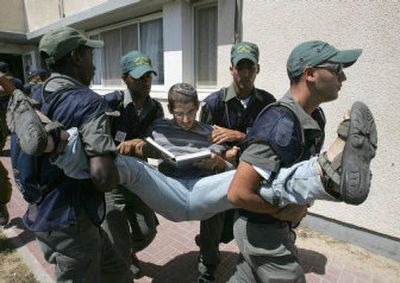Gaza pullout nearly completed

JERUSALEM – Only one Jewish settlement in Gaza remained to be cleared by the end of Sunday after Israeli troops moved quickly through a handful of communities during the day, encountering light, mostly symbolic resistance from the few families and holdouts still inside.
Soldiers finished evacuating six more settlements Sunday, breaking through flaming barricades and enduring tearful pleas from residents in the north and south of the Gaza Strip. The work left only Netzarim, an isolated community hit hard over the years by Palestinian attacks, to be cleared today when Israeli soldiers push to conclude the most grueling phase of the operation.
“It’s only symbolic that this is the last settlement to be evacuated,” Maj. Gen. Dan Harel, chief of Israel’s Southern Command, said Sunday evening. “Netzarim was attacked many times and has had casualties among the settlers and the soldiers who have protected them.”
The Israeli operation to clear 8,500 settlers and more than 1,000 other Israelis who arrived to oppose the evacuation has moved far more swiftly than military officials had envisioned. Once projected to last as long as six weeks, the Gaza evacuation likely will be concluded after just one week.
Prime Minister Ariel Sharon, who pushed the withdrawal at great political expense, praised the Israeli soldiers Sunday for their restraint and patience after days of taunts, attacks with rudimentary weapons and difficult hours on doorsteps in the 21 Jewish settlements.
But Sharon called “very serious” the more violent tactics of demonstrators who have arrived from outside the Gaza settlements, many of them from the West Bank, where the evacuation of four small communities is scheduled for later this week.
“Some of their actions could be defined as acts of hooliganism that bordered on the criminal,” Sharon said before the weekly Cabinet meeting, during which the final set of evacuations was approved.
Sharon suggested leaders of the settlement movement, which he had supported strongly over the years, would come under investigation for their role in organizing the opposition. Harel said later Sunday that only 1,500 Israelis from outside Gaza had entered the strip in recent weeks, calling the figure of 4,000 infiltrators initially given by settlement leaders an exaggeration.
“This reflects not only on them but also on those who dispatched them, incited them and handled them,” Sharon said of the scattered acts of violent resistance. “This was not done in secret but in the open, and it seems to me that we have not yet reached the end of the matter.”
Israeli soldiers began the day at the settlement of Qatif, where military bulldozers had to break through a flaming barricade at the entrance. Only a few of the community’s 74 families remained, some of whom had celebrated a bar mitzvah ceremony only a day earlier. Those still inside the settlement left with little resistance.
Synagogues were evacuated peacefully in Qatif and two other settlements in contrast to the tremendous resistance mounted last week from the rooftop of the synagogue in Kfar Darom, perhaps the signature and certainly most violent moment of the operation. More than 20 Israeli soldiers were treated in hospitals for slight injuries following the operation, and more than 100 Israelis were arrested.
A small stage set greeted soldiers arriving in Atzmona, where Israeli military officials originally had expected stiff resistance but met little Sunday. In front of one house, several cardboard tombstones stood in what was labeled the “Cemetery of the Oppressors.” Among the mock graves were ones for the late Palestinian leader Yasser Arafat and Adolf Hitler.
Another tombstone bore no name but likely was meant for Sharon, who has argued that leaving Gaza – where only a few thousand Jews have lived under military protection amid 1.3 million Palestinians – will help Israel define more defensible borders and protect its Jewish majority by shedding the strip’s fast-growing Arab population.
Israeli forces began destroying homes in three Gaza settlements on Sunday, the next phase in Israel’s operation to leave territory it has occupied since the 1967 Middle East war.
The Israeli settlements occupy roughly 20 percent of the Gaza Strip, land that Palestinian leader Mahmoud Abbas plans to place under the trusteeship of the Palestinian Authority. The government is considering housing, agricultural projects, industrial zones and tourist sites for the property once the Israelis have left.
Meeting with Abbas on Sunday in Gaza, C. David Welch, the U.S. assistant secretary of state for Near Eastern affairs, said the evacuation will help push Israeli and Palestinian negotiators back toward the “road map,” a staged plan to establish a Palestinian state alongside Israel.
“The United States views the Israeli disengagement from Gaza as an important opportunity to re-energize the road map, to take further steps forward toward a better future for Israelis and Palestinians,” Welch said.